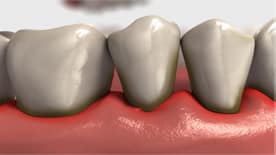 Example of periodontitis.
Example of periodontitis.
Recent research indicates that periodontitis may be associated with the development of cardiovascular disease. One theory is that the inflammatory proteins and the bacteria in the periodontal tissue enter the blood stream and cause various effects on the cardiovascular system. A recent study1 examined the presence of bacteria known to cause periodontitis and the thickening of the blood vessel wall commonly seen in heart disease. After examining samples from more than 650 subjects, the investigators concluded that an increased level of blood vessel thickening was associated with the presence of the same bacteria found in dental plaque known to cause periodontitis.
Many aspects of your health should be considered when assessing your periodontal status and developing comprehensive treatment plans. For those at risk for developing or those with preexisting cardiovascular disease, critical factors to consider include the severity of the disease; the duration of your disease; the presence of other medical conditions, such as diabetes, that may affect the cardiovascular disease; and the presence of concurrent risk factors for periodontal diseases. In addition, the dentist may communicate with your physician to determine the level of care, treatment for the condition, and your general well-being.
Reducing bacteria and eliminating biofilm, both above and below the gumline, are integral to oral and systemic health. This can be accomplished with traditional scaling and root planing in addition to excellent home care. Oral hygiene instructions are an important part of the treatment plan for all patients, particularly for high-risk patients, like those with cardiovascular disease. Treatment should focus on the prevention of periodontal disease and oral inflammation, which is essential in controlling the oral complications associated with cardiovascular disease. And because we know that bacterial challenge is a risk factor for gingivitis among even healthy patients, patients should be encouraged to floss regularly and brush twice daily with a toothpaste that offers antibacterial protection.
© Copyright 2009 Colgate-Palmolive Company
Reference
1. Circulation. 2005 Feb 8; 111(5):576-82.
11/15/2010

 Example of periodontitis.
Example of periodontitis.



